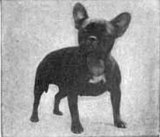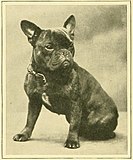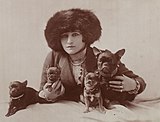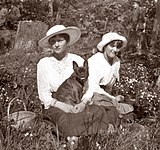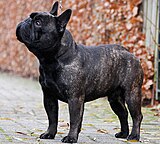User:NatasaEleftheriou/French Bulldog
| French Bulldog | |||||||||
|---|---|---|---|---|---|---|---|---|---|
 French Bulldog in Los Angeles | |||||||||
| Other names | Bouledogue Français | ||||||||
| Common nicknames | Frenchies | ||||||||
| Origin | France[1] | ||||||||
| |||||||||
| Dog (domestic dog) | |||||||||
The French Bulldog (also known as the "Frenchie) is a breed of domestic dog. In the 1800s, they were the result of a cross between Toy Bulldogs imported from England and local ratters in Paris, France.[3]
The breed is popular as a pet; in 2018, they were the first most popular registered dog in the United Kingdom,[4] and in the U.S., the fourth-most popular AKC-registered dog breed.[5] They were rated the third-most popular dog in Australia in 2017.[6] The French Bulldog also had 260 export pedigrees in the United Kingdom[7] and a total of 36,785 of registered French Bulldogs in the United Kingdom in the past decade.[8]
History
[edit]The origin of the modern French Bulldog breed descends directly from the dogs of the Molossians, an ancient Greek tribe. The dogs were spread throughout the ancient world by Phoenician traders. British Molossian dogs were developed into the English Mastiff, a sub-breed of the Mastiff was the Bullenbeisser, a type of dog used for bull-baiting.[9]
Blood sports such as bull-baiting were outlawed in England in 1835, leaving these "Bulldogs" unemployed;[9] however, they had been bred for non-sporting reasons since at least 1800, so their use changed from a sporting breed to a companion breed. To reduce their size, some Bulldogs were crossed with terriers, ratter dogs from the "slums" of England. By 1850, the Toy Bulldog had become common in England and appeared in conformation shows when they began around 1860.[citation needed] These dogs weighed around 16–25 pounds (7.3–11.3 kg), although classes were also available at dog shows for those who weighed under 12 pounds (5.4 kg).[9]
At the same time, lace workers from Nottingham who were displaced by the Industrial Revolution began to settle in Normandy, France.[10] They brought a variety of dogs with them, including Toy Bulldogs.[11] The dogs became popular in France and a trade in imported small Bulldogs was created, with breeders in England sending over Bulldogs that they considered to be too small, or with faults such as ears that stood up. By 1860, there were few Toy Bulldogs left in England, such was their popularity in France and due to the exploits of specialist dog exporters.[12]
The small Bulldog type gradually became thought of as a breed, and received a name, the Bouledogue Francais.[12] This Francization of the English name is also a contraction of the words boule (ball) and dogue (mastiff or molosser). The dogs were highly fashionable and were sought after by society ladies and Parisian prostitutes alike, as well as creatives such as artists, writers, and fashion designers.[12] There is record of artists named Edgar Degas and Toulouse-Lautrec who have been thought to have French Bulldogs in their paintings.[13] However, records were not kept of the breed's development as it diverged further away from its original Bulldog roots. As it changed, terrier stock had been brought in to develop traits such as the breed's long straight ears.[12]
- French Bulldog Paintings in 1800s
-
Painting of Frenchie by Henri Toulouse-Lautrec
-
Painting of French Bulldog by Toulouse-Lautrec
-
Painting of Horse and Dog by Edgar Degas
-
Painting of french bulldog by Toulouse-Lautrec
Breed clubs and modern recognition
[edit]Bulldogs were very popular in the past, especially in Western Europe. One of its ancestors was the English bulldog. Americans had been importing French Bulldogs for a while, but it was not until 1885 when they were brought over in order to set up an American-based breeding program. They were mostly owned by society ladies, who first displayed them at the Westminster Kennel Club Dog Show in 1896.[citation needed] They arrived again in the following year with even more entries, where the judging of the breed would go on to have future ramifications. The judge in question at the dog show, a Mr. George Raper, only chose winners with "rose ears"—ears that folded at the tip, as with the standard for Bulldogs.[14] The ladies formed the French Bull Dog Club of America and created the breed standard which stated for the first time that the "erect bat ear" was the correct type.[15]
In the early 20th century the breed remained in vogue for high society, with dogs changing hands for up to $3,000 and being owned by members of influential families such as the Rockefellers and the J. P. Morgans. The American Kennel Club recognized the breed quickly after the breed club was formed, and by 1906 the French Bulldog was the fifth most popular dog breed in America.[16] In 2013, the American Kennel Club (AKC) ranked the French Bulldog as the 11th most popular breed in the United States, enjoying a sharp rise in popularity from 54th place a decade before, in 2003.[17] By 2014, they had moved up to become the ninth most popular AKC registered dog breed in the USA and by the 2017 they were the fourth most popular.[5]
This new Bulldog breed arrived for the first time in England in 1893, with English Bulldog breeders in an uproar as the French imports did not meet the new breed standards in place by this time and they wanted to prevent the English stock from crossbreeding with the French. The Kennel Club initially recognized them as a subset of the existing Bulldog breed rather than an entirely new breed.[12] Some English breeders in this period bred the French Bulldogs in order to resurrect the Toy Bulldog.[10] On 10 July 1902, at the house of Frederick W. Cousens, a meeting was held to set up a breed club in order to seek individual recognition for the French breed.[15] The adopted breed standard was the same one which was already in use in America, France, Germany and Austria.[10] Despite opposition from Miniature Bulldog (the new breed name for the Toy Bulldog) and Bulldog breeders,[18] in 1905, the Kennel Club changed its policy on the breed and recognized them separate from the English variety, initially as the Bouledogue Francais, then later in 1912 with the name changed to the French Bulldog.[15]
Historical photos of French Bulldogs
[edit]-
1890
-
1901, Maurice in New York City
-
1901, Ch. Rico
-
1905, Diabutsu and Dimboola
-
1908, Anna-Maria Sacher
-
1911
-
1911, Ch. Stanmore Argus
-
1915
-
between 1875 and 1917
-
1917 with Grand Duchesses Tatiana and Anastasia Nikolaevna of Russia
-
Bulldog French
Description
[edit]The New Complete Dog Book: Official Breed Standards and All-New Profiles for 200 Breeds, 21st Edition, is an official publication of the American Kennel Club and sets forth the Official Breed Standard for all breeds recognized by the AKC. Its specifications for the French Bulldog state that it should be muscular, with a soft and loose coat forming wrinkles.[11] Some other breed characteristics and standards follow in this section in the next paragraph.
The AKC Standard weight for a French Bulldog is maximum 28 pounds.[19] The head of a french bulldog should be square shaped and large along with ears that symbolized bat ears.[19] French bulldogs are also known as a flat faced breed.[20] Eyes that are AKC Standard approved for French Bulldogs are dark and almost to the point of being black.[19] Blue eyed french bulldogs are not AKC approved.[19] The coat of a french bulldog should short haired and fine and silky.[21] Acceptable colors under the breed standard are the various shades of brindle, fawn, cream or white with brindle patches (known as "pied"). The fawn colors can be any light through red.[19] The most common colors are brindle, then fawn, with pieds being less common than the other colors.[22] The breed clubs do not recognize any other colors or patterns.[19] This is because some colors come linked with genetic health problems not usually found in the breed. These include blue coloration, which is linked with a form of alopecia (hair loss or baldness), sometimes known as "Blue Dog Alopecia".[23] Although this is heavily disputed by some organizations,[24] it has been suggested that the health, hair and skin conditions are caused by the color pigment (melanin) clumping in the hair shaft itself.[25] Even dogs that are not blue can develop "blue dog alopecia" or canine follicular dysplasia.
- French Bulldogs colors
-
Brindle color
-
Pied Color
-
Cream Color
-
Fawn Color
-
Black color
-
Blue Color (not AKC approved)
Temperament
[edit]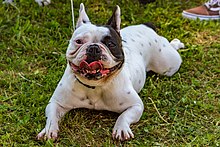
The French Bulldog, like many other companion dog breeds, requires close contact with humans. If left alone for more than a few hours, they may experience separation anxiety.[26][27] This is especially true when they are young, but persists into adulthood.[28] Its anxiety may lead a French Bulldog to behave destructively and for its housebreaking to fail.[29]
The French Bulldog is sometimes called a "Frog dog" or a "Clown dog." "Frog dog" is in reference to their wide round face and the way they sit with their hind legs spread out. "Clown dog" is because they are considered to be fun-loving, and indeed they have been described as the "clowns of the dog world."[30]
French Bulldogs are often kept as companions.[11] They rarely bark.[31] The breed is patient and affectionate with their owners and can live with other breeds. French Bulldogs are agreeable dogs and are human/people oriented dogs as this makes them on the easier side to train even though they do have tendencies to be stubborn.[11] It is noted that socializing puppies[32], including french bulldogs, can significantly impact the training of the puppy positively and is recommended.[11][33]
They are ranked 109th in Stanley Coren's The Intelligence of Dogs.[34] There are certain exceptions to this average level of canine intelligence; a French Bulldog named Princess Jacqueline which died in 1934 was claimed to understand 20 words, reacting correctly.[35]
Care
[edit]French Bulldogs do have certain health issues that owners can help avoid with proper care.[36] For one, they have fairly minimal exercise needs,[11] but do require at least daily short walks. Since French bulldogs fall into the dog category of a so-called "flat faced dog", too strenuous of exercise that results in heavy breathing specifically in hot temperatures should be avoided.[37] While at risk for obesity, if you take french bulldogs on daily walks, track their caloric intake by not overfeeding them, or feeding them foods high in fat, and also weighing them regularly, this can help minimize some deeper health issues that can take place when French bulldogs become obese.[36] Exercise is a wonderful way to keep french bulldogs healthy[38] but it is imperative and recommended that french bulldogs should not be allowed near bodies of water as they are not capable of swimming due to their bodily structure being so heave towards their front.[37]
Grooming for a french bulldog is fairly easy and requires some brushing as french bulldogs have a short, fine and silky coat.[37] However, as a french bulldog has many wrinkles in the face, it is advised that one should clean between the wrinkles and keep them dry.[37] As most dogs, french bulldogs will need the occasional bath but a brushing should suffice most of the time in order to have hair oils distributed evenly through the coat to maintain a natural shine.[37]
The AKC recommends that French bulldogs have health evaluation tests on hip dysplasia, a patellar evaluation, and ophthalmologist evaluation, and a cardiac exam as french bulldogs can have health problems in these area.[11]
Health
[edit]
A UK breed survey report on 71 dog deaths put the average lifespan of French Bulldogs at 8 to 10 years, while the UK breed club suggests an average of 12 to 14 years.[2][39] The AKC lists that the French Bulldog breed has a lifespan of 11 to 13 years.[40]
In 2013 a UK Medical Study reviewed the health of 2228 French Bulldogs under veterinary care in the UK.[41] The study found that 1612 (72.4%) of these French Bulldog had at least one recorded health issue[42]: "The most common disorders recorded were ear infections (14.0%), diarrhea (7.5%) and conjunctivitis (3.2%). Skin problems were the most commonly reported group of disorders (17.9%). This study of over two thousand French Bulldogs provides a framework to identify the most important health priorities in French Bulldogs in the UK and can assist with reforms to improve health and welfare within the breed."[43]
Patella issues
[edit]Patellar luxation is the dislocation of the patella. In dogs, the patella is a small bone that shields the front of the stifle joint in its hind legs. This bone is held in place by ligaments. As the knee joint is moved, the patella slides in a groove in the femur. The kneecap may dislocate toward the inside (medial) or outside (lateral) of the leg. This condition may be the result of injury or congenital deformities. Patellar luxation can affect either or both legs.[citation needed]
Temperature regulation-related issues
[edit]The French bulldog has only a single short coat. which combined with their compromised breathing system, makes it impossible for them to regulate their temperature efficiently.[24] This means the dog may easily become cold, and are prone to heat stroke in hot and humid weather. In terms of grooming, the French Bulldog requires regular nail trimming, brushing, occasional bathing, and ear cleaning.[44][11] French Bulldogs are also prone to allergies, which can cause eczema on the body.[45] Allergies can be caused by foods, insect bites, and French Bulldogs can also be frequently prone to hay fever and ophthalmic diseases.
As they are a brachycephalic breed, French Bulldogs are banned by several commercial airlines due to the numbers that have died while in the air.[46] This is because dogs with snub noses find it difficult to breathe when they are hot and stressed. The temperature in a cargo space in an aircraft can rise as high as 30 °C (86 °F) when waiting on the runway.[47]
It is also recommended that some French Bulldogs to live indoors have access to air conditioning to regulate their temperature if they are at higher risk.[39]
Birth and reproduction
[edit]French Bulldogs frequently require artificial insemination and Caesarean section to give birth, with over 80% of litters delivered this way.[48][49] Many French Bulldog stud dogs are incapable of naturally breeding. This is because French Bulldogs have very slim hips, making the male unable to mount the female to reproduce naturally. Therefore, breeders must undertake artificial insemination of female dogs. Female French bulldogs can also have erratic or 'silent' heats, which may be a side effect of thyroid disease or impaired thyroid function. French Bulldogs average around three puppies per litter.[50][51]
Back and spine
[edit]French Bulldogs can also be prone to an assortment of back, disk and spinal diseases and disorders, most of which are thought to be related to the fact that they were selectively chosen from the dwarf examples of the Bulldog. This condition is also referred to as chondrodysplasia. French bulldogs are prone to having congenital hemivertebrae (also called "butterfly vertebrae"),[52][53] which will show on an X-ray.[54] More advanced technologies such as myelograms, CT scans, or magnetic resonance imaging are used to detect spinal cord compression.
In October 2010, the UK French Bulldog Health Scheme was launched.[39] The scheme consists of three levels: the first level, Bronze, designates a basic veterinary check which covers all the Kennel Club Breed Watch points of concern for the breed. The next level, Silver, requires a DNA test for hereditary cataracts, a simple cardiology test, and patella grading. The final level, Gold, requires a hip score and a spine evaluation. The European and UK French Bulldog fanciers and Kennel Clubs are moving away from the screw, cork-screw or 'tight' tail (which is an inbreed spinal defect),[55] and returning to the short drop tail which the breed originally had.[56] The UK breed standard now states that the tail should be "undocked, [delete 'very'] short, set low, thick at root, tapering quickly towards tip, preferably [delete 'either'] straight, [delete 'or kinked'] and long enough to cover anus. Never curling over back nor carried gaily."[57]
Eyes
[edit]French Bulldogs have a tendency towards eye issues. Cherry eye, or an everted third eyelid, has been known to occur, although it is more common in Bulldogs. Glaucoma, retinal fold dysplasia, corneal ulcers and juvenile cataracts are also conditions which have been known to afflict French Bulldogs. Screening of prospective breeding candidates through the Canine Eye Registration Foundation (CERF) can help eliminate instances of these diseases in offspring. The skin folds under the eyes of the French bulldog should be cleaned regularly and kept dry. Tear stains are common on lighter-colored dogs.
Brachycephalic Airway Obstructive Syndrome
[edit]This is a syndrome occurs in french bulldogs and causes them to have multiple side effects as in difficulty breathing (which includes snoring, loud breathing).[39] It happens in french bulldogs because they have narrow nostril openings, a long soft palate and fairly narrow tracheas.[39] This issue can lead to death in French Bulldogs if they are not undergoing proper treatment.[39] Increased factors should be taken into account like weather conditions and if the dog is high energy/excitement, or if the dog has any possible allergies.[39]
In order to treat these dogs and create a smoother airway to the lungs, a procedure must be done that takes out a portion of their soft palate.[39] The results of the procedure show a minimum of 60% better airway passage to the lungs. [39]
Because of the Brachycephalic Airway Obstructive Syndrome, French Bulldogs must be managed in hot weather to make sure they have significant electrolytes and are kept track of.[39] If the dog does show symptoms of overexertion and extremely heavy and dangerous breathing, it is recommended that the dog be hosed off with cool water for about 15 minutes until the dog seems to have calmed.[39]
French Bulldogs in Pop Culture
[edit]French Bulldogs are a very popular breed today[4] and are very prevalent in social media culture. There is even a subreddit page that discusses "all things french bulldog"[58]. This section discusses their cultural legacy in dog shows, movies and television shows, celebrities who own them, and french bulldogs in famous events.
Dog Show History
[edit]While no French Bulldogs have been Best in Show at either Crufts or the Westminster Kennel Club Dog Show, during the 1950s a French Bulldog won Best of Breed for eight years in a row at Westminster; the run ended with the dog's retirement after the 1960 show.[59] The dog's owner, Amanda West, went on to win Best of Breed with other French Bulldogs for a further 10 years.[60] In 2010, a Canadian French Bulldog became the first of his breed to win the Non-Sporting Group[61] and make it through for consideration at the Best in Show round, eventually losing to a Scottish Terrier, Roundtown Mercedes of Maryscot.[62]
Movies and Television
[edit]Jason Schwartzman's French Bulldog, Arrow, made a cameo in his HBO detective comedy series Bored to Death in October 2010.[63] The movie Due Date ,filmed in 2010, starring Zach Galifinakis, Robert Downey Jr., & Jamie Foxx also features a French Bulldog named Honey.[64] In a newer television show Queer Eye, a french bulldog named Bruley would make an appearance every show.[65] Unfortunately, Bruley passed away in October 2019.[65] A 2003 film, Bringing the House Down, also features a French Bulldog.[66] There also is another 2003 film called Secondhand Lions that features a white french bulldog.[67]
Celebrities Who Own French Bulldogs
[edit]There are several celebrities who own french bulldogs whom are very notable. Denise Richards for one is a french bulldog owner and can be seen bringing her french bulldog to sets that she acted on.[68] Dwayne "The Rock" Johnson also owns a french bulldog as a companion.[68] The well known couple of Chrissy Teigan and John Legend own a beige Frenchie as well.[68] High profiled celebrities like Madonna and Lady Gaga also are owners.[68] Actress and singer Hilary Duff owns a french bulldog named "Beau".[68] Hugh Jackman, an Australian actor, is well known and often photographed running errands with his Frenchie.[68] Reese Witherspoon, an American actress, was seen photographed walking her pet french bulldog in 2008.[68] Another notable celebrity is Ashley Olson, one of the two Olson Twins, was spotted carrying her french bulldog around New York City in 2011.[68]
French Bulldogs in Events
[edit]The only French Bulldog aboard the RMS Titanic went down with the ship on 15 April 1912. First class passenger Robert Williams Daniel, a 27-year-old banker, had purchased the dog, named Gamin de Pycombe, for £150 (the equivalent of $17,000 in today's prices). A surviving passenger said that they had seen a French Bulldog swimming in the ocean after the ship sank.[69][70]
See also
[edit]References
[edit]- Specific
- ^ "Official standard from FCI (The Fédération Cynologique Internationale is the World Canine Organisation. It includes 91 members and contract partners (one member per country) that each issue their own pedigrees and train their own judges)", 'Official standard from FCI.'
- ^ a b "Summary results of the Purebred Dog Health Survey for French Bulldogs" (PDF). Kennel Club/ British Small Animal Veterinary Association Scientific Committee. Retrieved 4 April 2011.
- ^ "Le bouledogue Français, Ses origines", 'Official breed club created in 1898 (fr)'
- ^ a b "Top Twenty Breeds In Registration Order For The Years 2017 And 2018" (PDF). The Kennel Club (UK). February 2019. Retrieved 1 June 2015.
{{cite web}}: CS1 maint: url-status (link) - ^ a b "AKC: Most Popular Dog Breeds of 2018". The American Kennel Club.
{{cite web}}: CS1 maint: url-status (link) - ^ "Top 10 dog breeds in Australia 2017. Don't worry, they're all adorable". NewsComAu. Retrieved 12 April 2017.
- ^ "UK Export Pedigrees Issued in 2018" (PDF). The Kennel Club.
{{cite web}}: CS1 maint: url-status (link) - ^ "COMPARATIVE TABLES OF REGISTRATIONS FOR THE YEARS 2009 - 2018 INCLUSIVE" (PDF). The Kennel Club UK.
{{cite web}}: CS1 maint: url-status (link) - ^ a b c Coile (2005): p. 5
- ^ a b c Leighton (1907): p. 58.
- ^ a b c d e f g h "Get to Know the French Bulldog", The American Kennel Club, retrieved 28 May 2014.
- ^ a b c d e Coile (2005): p. 6
- ^ "French Bulldog Dog Breed Information". American Kennel Club. Retrieved 31 January 2020.
- ^ "History of the FBDCA". French Bull Dog Club of America. Retrieved 2 January 2019.
- ^ a b c Coile (2005): p. 7
- ^ Coile (2005): p. 8
- ^ American Kennel Club 2013 Dog Registration Statistics Historical Comparisons & Notable Trends, The American Kennel Club, Retrieved 28 May 2014
- ^ Leighton (1907): p. 59
- ^ a b c d e f Club, American Kennel. "American Kennel Club - Dog Breed Standards" (PDF).
{{cite web}}: CS1 maint: url-status (link) - ^ "French Bulldog AKC".
{{cite web}}: CS1 maint: url-status (link) - ^ "French Bulldog AKC".
{{cite web}}: CS1 maint: url-status (link) - ^ American Kennel Club (11 November 2014). The New Complete Dog Book: Official Breed Standards and All-New Profiles for 200 Breeds, 21st Edition. i5 Publishing. p. 912. ISBN 9781621870913.
- ^ "Introducing the French Bulldog". French Bulldog Club of England. Archived from the original on 6 August 2011. Retrieved 14 October 2011.
- ^ a b "10 Things You Didn't Know about the Blue French Bulldog". 13 October 2014.
- ^ "Color Dilution Alopecia". Dermatology For Animals. Archived from the original on 3 June 2015. Retrieved 1 June 2015.
- ^ "French Bulldog". PetDt Quickview. Retrieved 28 October 2018.
- ^ McCrave, Elizabeth A. (March 1991). "Diagnostic Criteria for Separation Anxiety in the Dog". Veterinary Clinics of North America: Small Animal Practice. 21 (2): 247–255. doi:10.1016/S0195-5616(91)50030-9. PMID 2053248.
- ^ Schwartz, Stefanie (June 2003). "Separation anxiety syndrome in dogs and cats". Journal of the American Veterinary Medical Association. 222 (11): 1526–1532. doi:10.2460/javma.2003.222.1526. PMID 12784957.
- ^ "Separation Anxiety in Dogs". www.petmd.com. petMD. Retrieved 26 March 2017.
- ^ "French Bulldog Breed: Fun Loving Clown".
- ^ "Learn why French Bulldogs make so many weird noises!". FrenchieWiki. 25 May 2018. Retrieved 4 July 2018.
- ^ "Puppy Socialization: How to Socialize a Puppy". American Kennel Club. Retrieved 31 January 2020.
- ^ "Puppy Socialization: How to Socialize a Puppy". American Kennel Club. Retrieved 31 January 2020.
- ^ Coren, Stanley (2006). The Intelligence of Dogs. London, UK: Pocket Books. p. 124. ISBN 978-1-4165-0287-6.
- ^ "French Bulldoge That Could Talk Dies of Pneumonia". Telegraph Herald. Woodward Communications, Inc. 16 October 1934. Retrieved 14 October 2011.
- ^ a b "French Bulldog Standard AKC".
{{cite web}}: CS1 maint: url-status (link) - ^ a b c d e "French Bulldog Dog Breed Information". American Kennel Club. Retrieved 31 January 2020.
- ^ Jan 22, AKC Staff; Jan 22, 2019 | 3 Minutes; Minutes, 2019 | 3. "Fat Dogs & Dog Obesity: How to Help Your Dog Lose Weight". American Kennel Club. Retrieved 31 January 2020.
{{cite web}}:|first3=has numeric name (help)CS1 maint: numeric names: authors list (link) - ^ a b c d e f g h i j k "The French Bulldog – Statement of The Health of The Breed". French Bulldog Club of England. Retrieved 1 June 2015.
- ^ "French Bulldog Care". American Kennel Club. Retrieved 3 June 2015.
- ^ "Demography and disorders of the French Bulldog population under primary veterinary care in the UK in 2013" https://cgejournal.biomedcentral.com/articles/10.1186/s40575-018-0057-9#Sec4
- ^ "Demography and disorders of the French Bulldog population under primary veterinary care in the UK in 2013" https://cgejournal.biomedcentral.com/articles/10.1186/s40575-018-0057-9#Sec4
- ^ "Demography and disorders of the French Bulldog population under primary veterinary care in the UK in 2013" https://cgejournal.biomedcentral.com/articles/10.1186/s40575-018-0057-9#Sec4
- ^ "French Bulldog Dog Breed Information". Akc.org. Retrieved 3 September 2018.
- ^ "French Bulldog". 2Puppies. Retrieved 25 November 2018.
- ^ Haughney, Christine (6 October 2011). "Banned by Many Airlines, These Bulldogs Fly Private". New York Times. Retrieved 8 October 2011.
- ^ White, Madeleine (7 October 2011). "Why are cute, snub-nosed dogs being banned from flying?". The Globe and Mail. Phillip Crawley. Retrieved 14 October 2011.
- ^ Evans, Katy M.; Adams, Vicki J. (2010). "Proportion of litters of purebred dogs born by caesarean section". Journal of Small Animal Practice. 51 (2): 113–8. doi:10.1111/j.1748-5827.2009.00902.x. PMID 20136998.
- ^ Pete Wedderburn (6 April 2009). "Why do over 80 per cent of Bulldog births happen by caesarian section?". The Daily Telegraph. Retrieved 5 August 2010.
- ^ "Why French Bulldogs cost so much?". Allstarfrenchbulldogs.com.
- ^ "How Many Puppies Do French Bulldogs Have in a Litter Normally?". French Bulldog Owner. 6 November 2018. Retrieved 15 April 2019.
- ^ "Hemivertebrae". Mar Vista Animal Medical Center. Archived from the original on 30 April 2015. Retrieved 21 December 2019.
- ^ "Genetic welfare problems of companion animals: Hemivertebrae". Universities Federation for Animal Welfare (UK). Archived from the original on 12 March 2015. Retrieved 21 December 2019.
- ^ "Hemivertebrae". Top Dog Animal Health. Retrieved 1 June 2015.
- ^ "Talking About Tails". French BulldogZ. Archived from the original on 7 June 2015. Retrieved 1 June 2015.
- ^ "The Kennel Club Dog Health Group, Annual Report 2013, SPECIAL FEATURE - FRENCH BULLDOGS" (PDF). The Kennel Club (UK). Retrieved 1 June 2015.
- ^ "About The French Bulldog Tail". Retrieved 1 June 2015.
- ^ "r/frogdogs". reddit. Retrieved 6 February 2020.
- ^ "Bulldog Extends Streak, Retirement Will End It". The New York Times. 9 February 1960.
- ^ "She's Top Dog Again This Year". The Owosso Argus-Press. Thomas E. Campbell. 10 February 1970. Retrieved 14 October 2011.
- ^ "Non-Sporting Group Results - All Winners of James F. Stebbins Trophy - WestminsterKennelClub.org". Archived from the original on 17 March 2013. Retrieved 21 December 2019.
- ^ "Scottish terrier takes Westminster dog show". CBC News Canada. 17 February 2010. Retrieved 14 October 2011.
- ^ Neff, Lauri (5 October 2010). "'Bored to Death' star's dog gets cameo on show". The Seattle Times. Frank A. Blethen. Retrieved 14 October 2011.
- ^ Archive-Kara-Warner. "Are Robert Downey Jr. And Zach Galifianakis A Good 'Due Date' Duo?". MTV News. Retrieved 6 February 2020.
- ^ a b CNN, Sandra Gonzalez. "Bruley, French bulldog from 'Queer Eye,' dies". CNN. Retrieved 6 February 2020.
{{cite web}}:|last=has generic name (help) - ^ "Bringing Down the House (film)", Wikipedia, 30 January 2020, retrieved 6 February 2020
- ^ "Secondhand Lions", Wikipedia, 1 February 2020, retrieved 6 February 2020
- ^ a b c d e f g h "Celebrities and Their French Bulldogs!". Us Weekly. 20 April 2017. Retrieved 6 February 2020.
- ^ Lynch 1992, p. 100.
- ^ "Frenchies and the Titanic". French Bulldog Club of America. Archived from the original on 31 December 2012. Retrieved 13 December 2012.
- General
- Coile, D. Caroline (2005). French Bulldogs. Hauppauge, N.Y.: Barron's. ISBN 978-0-7641-3031-1.
- Leighton, Robert (1907). The New Book of the Dog. London; New York: Cassell. ISBN 9781440089428.
- Lynch, Don (1992). Titanic: An Illustrated History. New York: Hyperion. ISBN 978-1-56282-918-6.
External links
[edit]- https://www.akc.org/dog-breeds/french-bulldog/
- https://www.thekennelclub.org.uk/services/public/breed/display.aspx?id=4088
Category:Bulldog breeds Category:Companion dogs Category:Dog breeds originating in France Category:FCI breeds



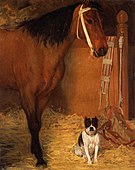

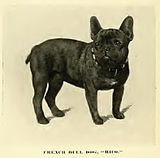
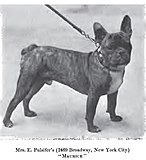
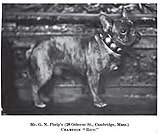

![1908, Anna-Maria Sacher [de]](http://upload.wikimedia.org/wikipedia/commons/thumb/f/f3/Anna-Maria-Sacher-1908.jpg/160px-Anna-Maria-Sacher-1908.jpg)
